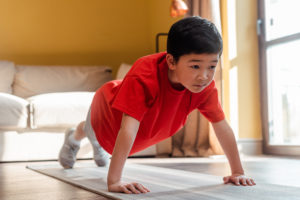As a coach or fitness professional who works with young athletes, you’ll encounter the question, “When is it safe for my child to lift weights?” multiple times in your career. Clear and relevant answers to this question often get lost in industry semantics, providing the concerned party with more questions than answers.
To better inform the concerned parties and put their mind at ease with this valuable training modality for their young athletes, it’s important to first acknowledge their concerns, then provide information in a clear and relevant way.
I have to admit, I used to get agitated when a parent or coach would express concerns about their young athlete holding a 5-pound dumbbell, particularly when they showed up carrying a 20-pound schoolbag. However, as experts, it’s important to put ourselves in non-expert shoes occasionally.

Considering the traditional culture of weight training, combined with the perceived culture of “hardcore” coaching, you can see how their concerns are relevant. However, when we’re able to explain both the process and advantages of resistance training in a clear and relevant way, we develop a relationship of trust. When we have a parent’s trust, we have an even greater opportunity to help their child.
Below I share some ways in which I’ve had success explaining the need, safety, and benefits of resistance training to concerned parents and coaches. Notice I use their language (i.e., “lifting weights”) so the message stays relevant to their specific concern.
Feel free to share this article, or adapt the information and share, however you see fit.
Humans are Born to Lift Weights
Bones and muscles work together to keep humans upright and moving, despite the forces of gravity. When we’re babies, our bones and muscles aren’t strong enough to do this job. Babies progress towards upright movement by crawling, half standing, and grabbing on to things when they move.
Each one of these movement progressions add slightly more weight from gravity onto their bones and muscles. The bones and muscles respond by getting stronger, allowing for better movement and stability.
Fast forward a few years and upright movement starts to become routine. A child’s bones and muscles are used to the combination of the forces of bodyweight against gravity. As kids move around more and gain access to different environments, their bones and muscles undergo new challenges.
Kids start to climb and hang from things. They jump and run. They carry and grip objects. Each of these introduces new demands for their bones and muscles to get stronger.
As you can see, children start “lifting weights” from the time they are born.
A coach’s job is to figure out ways to continue this process of adapting to new physical challenges in a safe, fun, and positive environment. Once a movement or activity becomes routine and easy, the process of learning slows down. To facilitate learning, coaches must find a way to turn “routine and easy” into “new and challenging.”
There are a quite a few ways to do this. Take the push-up movement for example. From a developmental standpoint, this exercise helps build upper body strength, shoulder mobility and stability, and overall core strength.
Let’s say a child can do 20-30 push-ups easily. How could a coach safely increase the level of challenge so learning, adaptation, and strength development continue?

- Challenge the young athlete to do more push-ups. This increases the demand on muscles and bones, but time may become a factor when it takes progressively more and more repetitions of different exercises to provide an adequate challenge. Additionally, once you start doing excessive repetitions of a particular exercise, overuse injuries start to show up.
- Put the athlete on an unstable surface (balance board, Swiss ball, etc.). This can increase the demand for proprioception and stability. However, depending on the age and level of athlete, this instability can become a safety hazard. Additionally, continued progress would require greater instability. At some point, safety becomes a concern at any age/level.
- Increase the child’s bodyweight against gravity by placing a lightweight vest, backpack, or medicine ball on their back. This new challenge to bones and muscles would most likely result in the child reaching muscle fatigue by 15 or fewer repetitions. This is great for time efficiency. Best of all, the process of adding slightly more resistance to a movement to make it more challenging can continue nearly indefinitely.
As you can see, all the above are viable options for increasing the challenge of a movement. However, when factors like time, safety, and long-term opportunities for progression are considered, you can see that adding resistance to a movement, or “lifting weights,” can be a safe, effective, and efficient choice.
Is “Lifting Weights” Safe for Kids?
There is now a mountain of research to support the safety and effectiveness of progressively making movement more challenging using med balls, sandbags, barbells, dumbbells, kettlebells, machines, and anything else that makes a movement more challenging for a child.
In the research, they refer to “lifting weights” as “resistance training.” Research on the safety and effectiveness of this type of training for kids has come to the following conclusions:

- Resistance training appears to decrease injury rates in young athletes
- Resistance training can improve coordination and overall proficiency with movement
- Resistance training can improve strength and force production
- Kids as young as 5 have been found to benefit from a resistance training program
- A well designed and supervised resistance training program is safe and effective for young athletes
Note that fears of damaged growth plates, stunted growth, and other similar concerns have been dispelled when examining the outcome of a properly designed and supervised resistance training program for kids.
These are just a few of the many benefits of youth resistance training cited in peer reviewed literature. If you want to take a deep dive into the research, here’s a link to the 258 supporting studies cited in the National Strength and Conditioning Association’s Position Statement on Youth Resistance Training.
How Much Weight is it Safe for Kids to Lift?
There is no magic number for the amount of weight considered “safe” for kids. Children are at different stages of development and have different body sizes and basic strength profiles. Remember, if a child can’t do a movement safely and effectively without extra resistance, any extra resistance increases the likelihood of injury.
When adding resistance to a movement, start conservatively. The benefits of resistance training will only be actualized when movements can be done safely and effectively. If a child can’t do at least 8-10 controlled repetitions with the new weight challenge, decrease the amount of resistance. If they can do more than 15 repetitions correctly and safely, add slightly more resistance to the movement.
When is Lifting Weights Not Safe for Kids?
Looking at the research, you can see that “properly designed and supervised” resistance training programs have shown to be safe for kids at nearly any age. Properly designed programs come from properly trained, experienced, and credentialed professionals.
The more trained, experienced, and credentialed a coach is for introducing resistance training to kids, the safer and more effective the program. Note that this rule can be extended to nearly every activity.
The recommended age to begin organized resistance training is between 7 and 8 years old. These guidelines are based on a child’s ability to follow directions and perform coordinated movement effectively. When kids are either too young or too unfocused to safely handle external implements (med balls, dumbbells, etc.) it presents a serious safety concern. This concern grows the larger the group size. Nearly all injuries involved with youth resistance training are due to dropping, tripping, or otherwise improperly using equipment.
 Even when young children are focused and capable of doing exercises correctly however, soft weighted implements like Sandbells®, soft medicine balls, and similar tools can provide the exact same resistance as the steel alternative (i.e., kettlebells, dumbbells, etc.) while decreasing the risk of common injuries. A 10-pound Sandbell® falling on a child’s toes has much less potential for injury than a 10-pound steel weight plate.
Even when young children are focused and capable of doing exercises correctly however, soft weighted implements like Sandbells®, soft medicine balls, and similar tools can provide the exact same resistance as the steel alternative (i.e., kettlebells, dumbbells, etc.) while decreasing the risk of common injuries. A 10-pound Sandbell® falling on a child’s toes has much less potential for injury than a 10-pound steel weight plate.
If a child is unable to manage the resistance of their bodyweight and gravity effectively, it wouldn’t make sense to add more resistance to the movement. This is true whether you’re working with kids, teens, or adults.
With the above being said, training with external implements (aka, “lifting weights”) can help kids develop the strength to be more successful with bodyweight exercises. For example, if your young athlete struggles with push-ups, doing a similar movement on a machine with resistance less than their bodyweight could allow them to progressively strengthen the muscles involved with doing a push-up.
What Results Can You Expect from Your Child Lifting Weights?
Resistance training is a safe, effective, and efficient way to help a child become more confident with sports and physical activity. As mentioned earlier, progressively adding resistance to movement helps kids safely improve coordination, strength, power, and overall health.
Prior to puberty, these improvements are due to the improved coordination from continually adapting to new challenges, not from an increase in muscle size.

Contrary to popular belief, lifting weights does not increase the size of muscles before puberty. Dramatic increases in the size of muscles happens because of significant hormonal influences that don’t come in to play until puberty and adulthood. Parents and coaches hoping to help a pre-pubescent child gain weight as a result of resistance training will be disappointed.
As you can see, when done as part of a properly designed and supervised program, “lifting weights” can be a valuable tool in the fight to help your kids develop the skills to become active and athletic for life.
Brett Klika CEO and co-founder of SPIDERfit is an international award- winning certified strength and conditioning coach, author, and motivational speaker with over 20 years experience motivating and inspiring youngsters to a life of health, fitness, and performance.
Brett consults with schools, athletic organizations, fitness professionals, and fortune 500 companies around the world.





Connect with SPIDERfit!